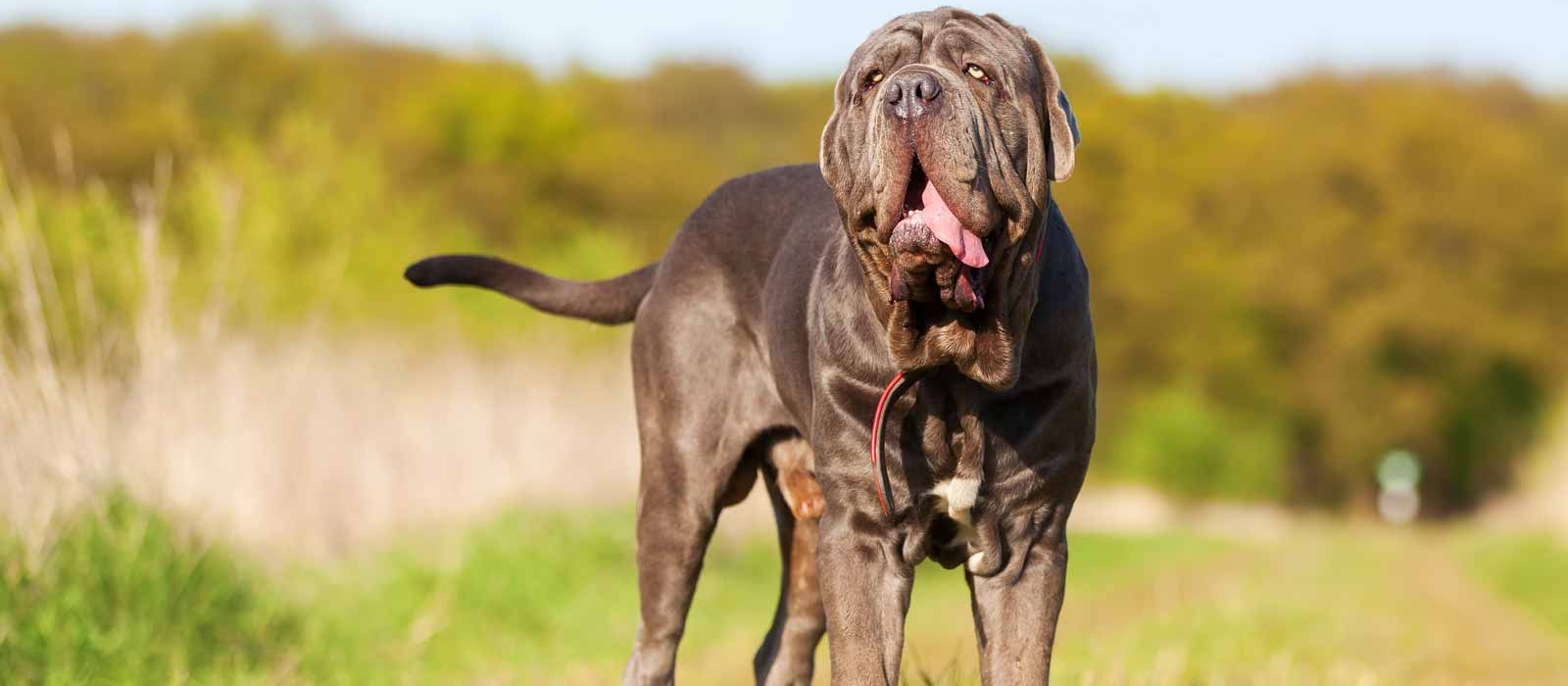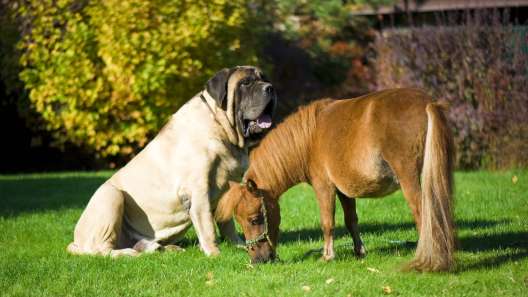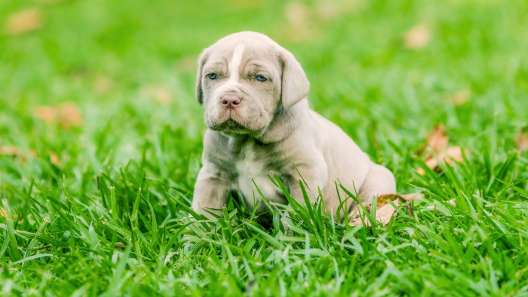-
Activity Level:
moderate
-
Shedding Level:
low
-
Grooming Level:
moderate
-
Trainability:
moderate
-
Good for Novice Owners:
low
-
Adaptability:
moderate
-
Kid/Pet Friendly:
often
-
Prey Drive:
low
-
Watchdog:
very alert
- Average Size: Giant
- Average Lifespan: 7-9 years
- Registered?: aca, akc
Neapolitan Mastiff Dog Breed Information
Overview
Temperament
Adaptability
Health
Owner Experience
Grooming
Activity Level
Size
Life Span
Did You Know?
Like their other Mastiff cousins, the Neapolitan Mastiff is a Molosser-type dog descended from the ancient canis pugnax. One of the facts about Neapolitan Mastiffs is that they have ancient ancestry. Their ancestry can be traced to as far back as 3000 BCE when this type of dog emerged in Tibet. During the Roman Empire, these dogs were gladiators, war dogs, and home guardians. They maintained popularity throughout Europe for centuries, but were almost lost after World War II.
After the war and rediscovering this ancient dog breed, Piero Scanziani, an Italian painter and reporter, founded a kennel to develop and breed the Mastiff-type dogs in Italy into the Neapolitan Mastiff. The goal was to create a massive guardian dog with loose, heavy skin that would serve to protect them during a fight. They also wanted dogs that would be loyal to their families and affectionate with them.
The Federation Cynologique Internationale (FCI), the international dog registry, recognized the Neapolitan Mastiff in 1949. Jane Pampalone is credited with bringing the first Neapolitan Mastiff to the United States in 1973. But, it’s important to note that Italian immigrants may have brought some dogs over as early as the 1880s.
The Neapolitan Mastiff Club of America, the first national breed club for the Neapolitan Mastiff, was formed in 1973. The United States Neapolitan Mastiff Club and the American Neapolitan Mastiff Association formed in the 1990s. The American Kennel Club recognized this dog breed as a member of the Working Group in 2004.
Although they grow to be big, powerful dogs that look intimidating, Neapolitan Mastiffs are known to be gentle giants with their families. They tend to have a sweet, gentle dispositions with their families and are affectionate and loving towards them. In fact, they often continue to act like a lap dog even when they are fully grown!
They tend to get along fantastically with children. But, they are generally better suited to homes with older children. Due to their size, even as puppies, and general clumsiness at times, they can easily knock over or step on young children and may hurt them accidentally. They do well with dogs, cats, and other pets that they are raised with, but do not warm up naturally to strange animals.
Their guardian background makes them naturally protective of their families and suspicious of strangers. Even after you welcome a stranger, a Neapolitan Mastiff may remain aloof until they get to know them. They don’t tend to bark a lot. But, you’ll know when they do because they have a deep, booming bark.
Socialization and training are important for any dog breed, but it is especially important for dogs with protective instincts. Although the Neapolitan Mastiff is typically not aggressive unless they’re given a reason to be, a poorly socialized dog with guardian and protective instincts can easily become territorial and view strangers as threats. Poor socialization and training are common causes of aggression in dogs.
Neapolitan Mastiffs are moderately adaptable dogs. They do better in larger homes with fenced-in yards that give them clear property boundaries they can patrol. They can adapt to apartment living as they are generally calm indoors and don’t require a lot of exercise. But, they are big dogs that like to sprawl and stretch out. They will have no issues knocking over stuff or even moving your furniture in order to find a comfortable place to rest.
This dog adapts well to most climates. But, they are particularly sensitive to heat and can overheat easily. You will need to take extra precautions in the heat and keep your dog cool during the summer. As with most dog breeds, they are also sensitive to extreme cold. They are okay with some alone time. However, they do bond closely with their families and are happiest around the people they love, so you don’t want to leave them alone for long periods of time.
As a giant dog breed, the Neapolitan Mastiff’s average life span is shorter than smaller dogs. They also can be more prone to certain types of health conditions like elbow dysplasia, hip dysplasia, cardiomyopathy, cleft palate, and cherry eye. Good breeding practices and the health of the parents make a big difference in the health of Neapolitan Mastiff puppies.
Reputable breeders will screen their stock to avoid passing genetic conditions on to puppies. So, make sure you ask the breeder about the genetic and health history of both of the parents. You can also ask to see any relevant health clearances or test results that are available. The United States Neapolitan Mastiff Club recommends a cardiac exam, an elbow evaluation, a hip evaluation, and an ophthalmologist exam.
Inherited skin issues are not common with Mastinos, but they can develop skin issues if their skin and wrinkles are not properly cared for. Grooming these dogs properly and caring for their wrinkles can help prevent skin issues and irritation.
Because the Neapolitan Mastiff is a giant dog breed, they are at a higher risk of bloat. Bloat in dogs can have serious consequences and can quickly become fatal if gastric torsion occurs (i.e.; if the stomach flips). As a dog owner, it’s important to know how you can reduce the risk of bloat and the signs of it so you when to get help immediately.
These dogs can also become quite lazy as they get older, which makes them prone to weight gain and obesity. If your dog is overweight, it can cause health issues and a shortened life span in any dog breed, but the effects are often magnified in a giant dog breed. Maintaining a good diet and having a good exercise routine for your dog can help keep your Neapolitan Mastiff at a healthy weight and avoid unnecessary health complications later in life.
The Neapolitan Mastiff is a big dog with a strong will. Although they love their owners and are eager to please them, they can also be stubborn and will often push the boundaries to see what they can get away with and whether you really mean what you say.
This can be overwhelming for a first-time dog owner to handle. As such, these dogs are recommended for more experienced owners, and puppy training classes are recommended. Regardless of owner experience, puppy training classes can still be a good idea because they often offer opportunities to socialize a puppy.
These dogs need firm, consistent training that is positive, encouraging, and rewarding. Bring plenty of patience as you’re training this dog and make sure you do not use harsh training methods. This will damage your bond with them, can make them even more stubborn, and can become why your dog doesn’t listen to you.
Neapolitan Mastiffs tend to work best in blocks of 10-20-minute training sessions. Keeping sessions short and focused can help keep your dog engaged during training sessions. In addition to mastering the basics early on, it’s important to continue training throughout your Neapolitan Mastiff’s life.
Oftentimes, many don’t reach the laid-back adult maturity they’re known for until they are 3 or 4 years old. You may need to be prepared for an extended teenage stubborn streak where consistency in training is even more essential.
Leash training early and often is also important. These puppies will grow into a huge, powerful dog that will be able to pull you wherever they want to go. Unless leash training is in place, walking this dog could be a nightmare once they are fully grown.
For the same reasons, it’s a good idea to train your dog not to jump up. Mastinos are big, heavy-boned puppies that grow into even bigger, heavier dogs that can easily knock over and injure someone. It’s also important not to wrestle or roughhouse with your Mastiff as a puppy. It may be cute when they’re little, but can quickly become dangerous once they’re fully grown.
Whenever you find yourself engaging with, rewarding, or encouraging certain behaviors and interactions when your Neapolitan Mastiff is a puppy, think about whether it’s still cute or acceptable when they are 150-200+ pounds. Essentially, if you don’t want your 200-pound dog doing it, don’t allow it as a puppy. This is an essential and valuable dog training tip.
The Neapolitan Mastiff has a short dog coat type that will shed a little year-round. Weekly brushing and the occasional bath, when needed, are usually enough for this breed. A rubber brush and a grooming glove are good dog grooming brush options for a Mastino coat. But, you will need to pay particular attention to their wrinkles and eyes.
You can clean their eyes and between wrinkles gently with a paper towel or damp cloth as needed. It’s also not a bad idea to have a drool cloth and air freshener on hand. Because of the droopy jowls, this dog breed is prone to drooling. They also tend to be quite gassy.
In addition to coat and wrinkle care, you will also need to care for your Neapolitan Mastiff’s nails, ears, and teeth. Once or twice monthly nail trimming is usually enough to keep nails from growing too long. But, if nails grow quickly or aren’t wearing down as much naturally, you may need to cut your dog’s nails more often.
Checking their ears weekly and cleaning your dog’s ears as needed can help prevent ear infections. You’re checking to make sure ears are dry, clean, and free of debris and pests. If you see redness, irritation, discolored discharge, or other issues, it’s time to go to the vet.
Gum disease is one of the most common health issues in dogs. Most of the time, it’s due to a lack of consistent dental care. Good dental care for dogs starts with using an enzyme toothpaste or brushing your dog’s teeth every day in addition to cleanings at the vet when needed. You can also work with your vet to supplement your efforts by creating a “dental care diet” for your dog and by using approved dental hygiene chews.
It’s important to get your Neapolitan Mastiff puppy used to having these grooming tasks done early on and to keep the experience as positive and rewarding as possible. Not only can this help build a bond with your dog, but this will also make grooming much easier as your puppy grows into a huge dog. It could even become something your dog looks forward to!
This dog breed tends to have a low to moderate activity level. Daily walks plus some playtime are usually enough for this dog. Neapolitan Mastiffs tend to be quite energetic when they are younger and can become couch potatoes as they grow and mature.
Because they are a giant dog breed, their bones and joints will take longer to develop. Puppies finish growing at different rates. For the Neapolitan Mastiff, this usually takes until they are about 2 years old or a little longer. It’s important to keep their activity low-impact before this point and even after they’re fully developed as well.
Jumping up and down, jumping on and off furniture, or running up and down stairs can all be extremely damaging to a developing puppy’s joints, especially for large and giant dog breeds. Neapolitan Mastiffs also tend to be quite clumsy, which can cause a host of other issues when it comes to stairs.
This dog breed also overheats easily, so you want to make sure they’re not overexerting themselves. You will need to be cautious in warm weather. It’s also recommended to avoid tug-of-war as well as wrestling games because this dog will be stronger than you at some point and may decide not to listen once they figure it out.
You can try swimming, which is a great low-impact exercise, but you will need to use a life vest, be vigilant, and practice other safety tips for swimming with your dog. This is a top-heavy dog. They don’t tend to swim well and they may have issues keeping their head above water on their own.
Short stints of free running in a fenced area and short walks on a leash are great activities for these puppies. Even after these dogs are fully grown, they won’t make a great running or jogging partner. That type of consistent, high-impact exercise damages their joints over time.
A fully-grown Neapolitan Mastiff usually stands 24-31 inches tall at the shoulder and weighs 110-150 pounds. This makes the Italian Mastiff one of the largest dog breeds in the world. And, these are just average heights and weights for this dog breed; some of them can grow to weigh over 200 pounds!
Neapolitan Mastiffs generally live for 7-9 years on average.
The Neapolitan Mastiff is also sometimes called an Italian Mastiff, a Mastino, and a Mastino Napoletano.








